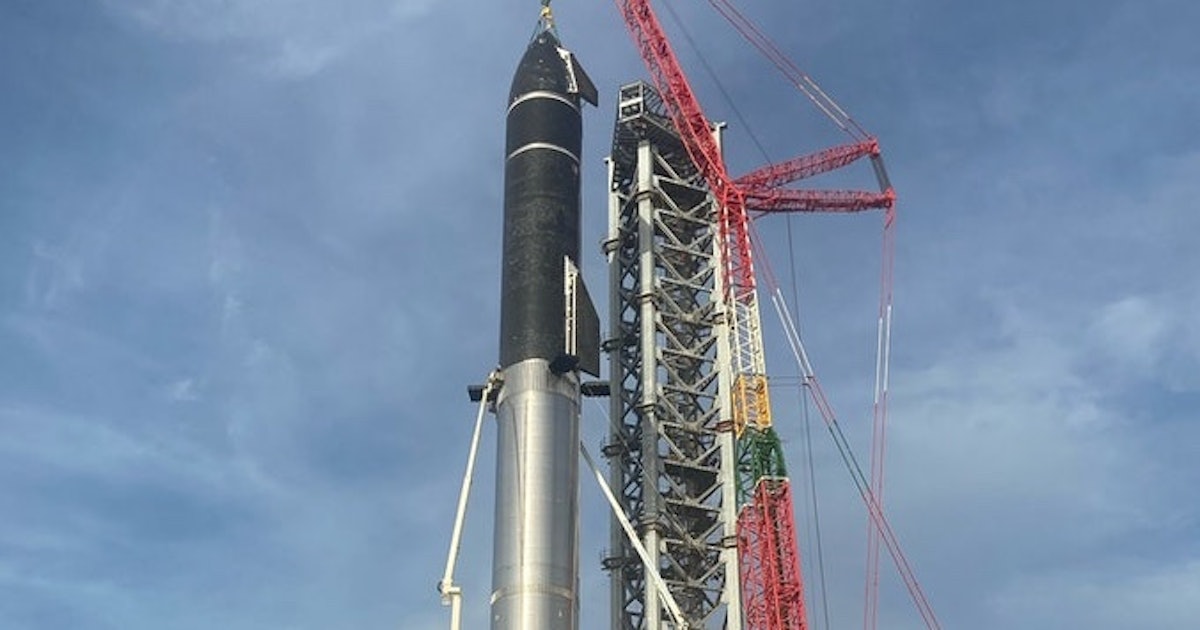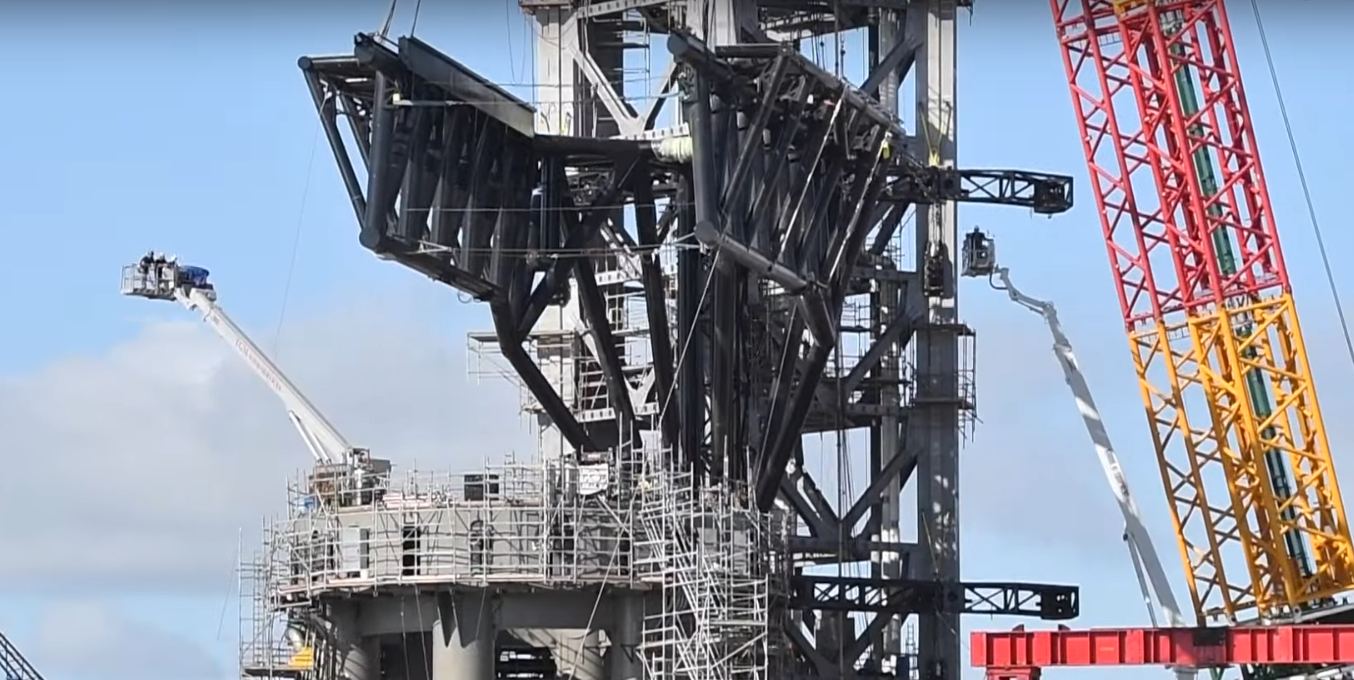
How Exactly Does Starship’s Catching Mechanism Work?
Starship is meant to be one of the biggest and most powerful rockets ever built. In addition to this, SpaceX is also working to make the 120m tall launch vehicle fully reusable. Unlike what we have seen with prior rockets such as the Falcon 9, SpaceX plans to catch both the first and second stage out of mid-air. To do this the private company is constructing and installing what is often called Mechazilla.
Starship will be caught out of mid-air by Mechazilla which consists of two large metal arms and a carriage. These metal structures are attached to the orbital launch integration tower. The catching mechanism can move up and down the tower, open and close the metal arms, and rotate from one side to another. This will allow SpaceX to catch, move, and stack each stage of Starship.
Catching Starship is necessary to not only save an immense amount of money but also speed up the landing and launch process. The project is very ambitious and has never been done before. However, if successful it would help propel SpaceX to success with future Starship missions to Mars and beyond.
What Is The Point Of Catching Starship?

Starship is SpaceX’s next-generation launch vehicle that is currently in development. Standing at 120m tall it will be the biggest and most powerful rocket in the world. With an estimated payload capacity of over 100 tons to low Earth orbit, the rocket will be capable of some incredible things. However, Starship is not only meant to be powerful but cost-effective as well. SpaceX is working to make Starship fully reusable. In the past, with rockets such as the Falcon 9, SpaceX worked to reuse the first stage by landing it on a drone ship. This is a great solution and saves the company time and money. After landing, SpaceX only has to refurbish the used booster prior to the next launch. This is a very convenient option but SpaceX wants more out of Starship.
SpaceX wants the launch cost to only be $2 million along with practically instant launches after landing. This means there will be no refurbishment or transportation of the rocket after being caught. This is where Mechazilla (catching mechanism) comes into play. SpaceX is working to catch both stages of Starship to save money and time. The unique opportunity that catching Starship presents is instant setup for the next launch. The mechanism can catch Super Heavy, place it on the launch mount, catch Starship, and stack it on top of the booster. In just a short period of time, you are ready for another Starship launch.
How Does The Catching Mechanism Work?
Construction – The first aspect of Starship’s catching mechanism is the construction. Mechazilla consists of 3 main parts. First is the two very large metal arms that will be responsible for catching both stages of Starship. These metal arms are about 36 meters in length allowing them to get a safe distance from the tower and easily stack the booster of Starship on the launch mount. The last main part is the large carriage. This is a metal structure that the two metal arms connect to. The carriage connects the metal arms to the launch tower. They do this with three points of contact on three of the four corners of the orbital launch tower. Throughout the catching mechanism, there is also a lot of different hydraulics. These are for different actions between catching and securing stages of Starship.
Vertical Movement – Now let’s look at the movement capabilities of Mechazilla. Starting with vertical movement up and down the launch tower. As I mentioned prior the metal arms are connected to a metal carriage that connects to the tower. In the multiple points of contact to the launch tower, the carriage contains mechanisms with large bearings allowing SpaceX to control its movement up and down the tower. To ensure everything happens at a safe and controlled speed the catching mechanism also is connected to a large cable. At the very top of the launch tower, there are multiple pulleys and a large cable. This connects to the launch tower and controls the descent and ascent of the catching mechanism. This is how Starship’s catching mechanism safely and in a controlled manner moves up and down.
This is necessary for a few aspects of the catching and stacking process. First is the catching aspect. As the booster and upper stage light their engines and slow down, the arms will likely partially move with the Starship stage and help smoothly catch the launch vehicle. This will reduce stress on both Starship and Mechazilla. Then there is the stacking process. Once successfully caught, the arms will need to move up and down to achieve the correct height for stacking. This applies first to Super Heavy on the launch mount and second to the Starship upper stage on top of Super Heavy.
Open & Close – The next aspect of Starship’s catching mechanism is the ability to open and close. This process helps simplify the catching process significantly. Starship will have to be extremely accurate when completing its final landing burn. When the arms are in a closed position they span just over the width of both Starship and Super Heavy. This would make it practically impossible for either rocket stage to descend between this tiny gap. Instead, the catching mechanism will be capable of opening and closing for this process. The arms will be wide open as the rocket stage descends making it easier to get positioned in between the catching arms. Once the majority of Super Heavy or Starship has descended between the arms, they will come together and close on either side of the launch vehicle. The catching mechanism will then catch both stages through load points at the top of Super Heavy and Starship. The open and close aspect gives SpaceX some room for error and a bit more space when each stage is descending.
Side To Side – The final feature of Mechazilla that I want to mention is the rotation from side to side. Both arms will be capable of rotating over the launch mount and off to the side of the launch tower. This partial rotation angle will help during the catching and stacking process. Rather than Super Heavy and Starship coming in for a landing over the launch mount, they will try off to the side. This helps ensure nothing is damaged by the engines or a possible failure. After the Starship stage is caught, the arms will rotate to the side until they are positioned over the launch mount. At that point, they can place and release each stage on the mount and booster.
Conclusion
SpaceX continues to come up with unique and ambitious ideas that are hard to believe. Catching Starship out of mid-air is one of those ideas. The private company plans to do it with what is called Mechazilla. This is a large metal structure with two arms and a carriage. This is connected to the launch tower and can move up and down, open and close, and rotate from one side to another. Each aspect helps with the catching and stacking process for Starship. This is meant to not only save SpaceX a lot of money on each Starship launch but also speed up the process significantly. Recently the mechanism was installed for the first time on the launch tower. As time goes on SpaceX will continue to test Starship and we will eventually see a Starship catch attempt.
